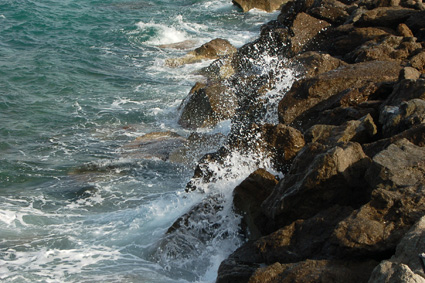
Sea spray along causeway, Naxos
Naxos is the sort of place people mean when they say they could spend the rest of their days on an island in the Mediterranean. (Or, in this case, the Aegean Sea.) Perhaps we'd have had a less engaging experience at the height of tourist season, but we were so off-season1 that much of the island was closed down. The main town, called either Chora or Naxos, was still alive, with the majority of the shops and restaurants open for business - but that was far from the case in the smaller resort towns, which were ghost towns save for the work crews readying the hotels for the coming tourist hordes.
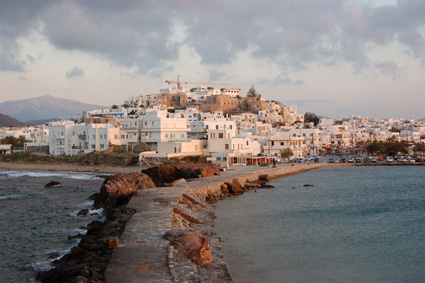
Chora, Naxos
Although it's possible to get puddlehopper flights to Naxos, most everyone arrives on the ferry. In the peak season, there are five or six ferries a day from Piraeus, the main port serving Athens, but we had a choice of two: one that left the mainland at 7:30am; another that wouldn't arrive in Naxos until nearly midnight. We opted for the former, and spent five rather comfortable hours aboard a monstrous ferry that had not only hundreds of travelers, but two decks' worth of cars, including several full-size semi trailers. Some got off at Paros, the only stop before Naxos, and some continued on to other islands, though we never did figure out which ones.
We arrived on a day that was like every other during our stay: brilliant sun, with enough haze in the air to make Paros seem far away, and a wind that made the days pleasant but the nights chilly. As far as we were concerned, the weather was wonderful, ideal for short sleeves and long walks. The locals, on the other hand, were bundled up in sweaters and jackets at pretty much all times, and were amazed that we'd left home with snow on the ground and wouldn't be surprised to have another significant snowfall once we went home.
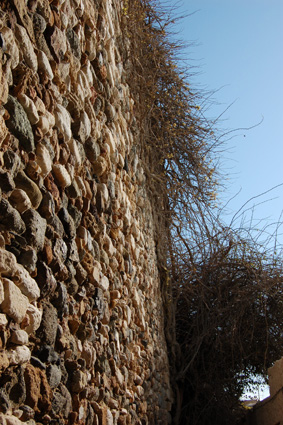
Coarse stone wall in Kastro
At the center of the old town is the Kastro, an ancient hilltop castle, though in a rather loose sense compared to the imposing fortresses that I think of as European castles. These days, it's a warren of narrow, twisting streets and stairs connecting residences, a pair of museums, and an old Roman Catholic church. For the most part, the buildings throughout the island - in the Kastro and elsewhere - are white plaster with blue shutters. In the Kastro, though, there are a few fascinating old rough stone walls, like above, and a sense of history in the mismatched architectural styles as buildings were patched, torn down, replaced.
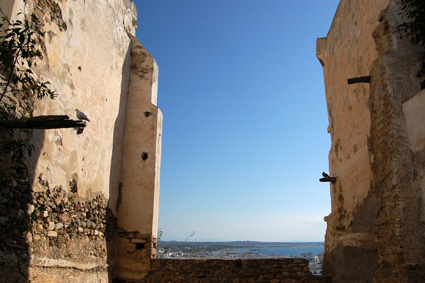
Fallen building within Kastro perimeter
Then, occasionally, there's something that remains fallen. When we first walked through the Kastro, it was during the midafternoon siesta, and everything was quiet, even the construction crew working on the historical buildings. Only the birds - pigeons, mostly - and the cats were active. Though there were a handful of stray dogs about the town, there were cats everywhere on the island. This fallen building seemed to be one of their favorite places to congregate, giving them a variety of places to perch and devour their kills; little bones of birds, rodents and fish littered the area. Still, we felt as though we had the entire place to ourselves, which, in a way, we did.
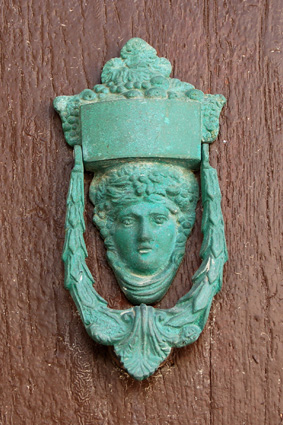
Door knocker detail, Kastro
Throughout Greece, we found a juxtaposition of charming, well-kept elements alongside old, crumbling wrecks. The Kastro was no different. The residences - presumably some of the most expensive real estate on the island - were in good repair, often with fascinating architectural details like the ornate door knocker above. Others maintained miniature gardens, with flowers, grape vines, and flowering trees, nestled within the nooks. But just a few steps away would be semi-derelict structures, with a patchwork of quick-fix repairs, which may or may not have been occupied.
The best-known sight on the island of Naxos, of course, is also a ruin. On a hill at the northwest edge of Chora, connected by a causeway, is the 2500-year-old Temple of Apollo, though nothing remains but the massive gate and scattered stones.
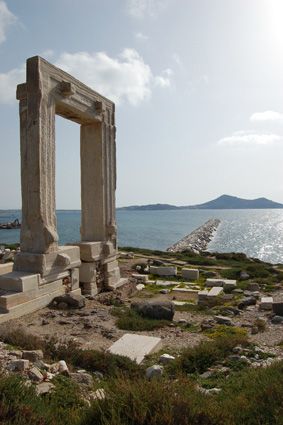
Temple of Apollo gate
In the summer, we're told, there's hardly a spot to stand around the temple, and it's obvious that the scraggly vegetation covering the hill takes a serious beating. A myriad of meandering little footpaths scatter every which way, and it's not a terribly large hill. The prettiest time to be there - and the time we saw the most people - was at sunset, because the west-ish facing gate frames the sunset quite well. Including ourselves, there were a total of six people on the hill, including a professional photographer who must have taken dozens of shots of the sunset, like this:
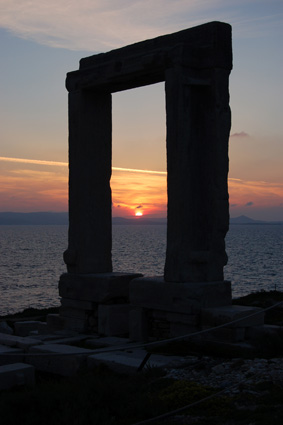
Temple of Apollo gate at sunset
Eating isn't a problem on Naxos, assuming you like seafood and don't mind limiting your vegetables to Greek salads. In essence, you can rely on it for your evening's entertainment, especially as we had the restaurants more or less to ourselves. Mezedes were the easiest way to go, particularly at night, though souvlaki and gyros made for simple lunches, especially when the island had settled into siesta time.
In Chora, it's tough to find someone who doesn't speak English - often before you even have time to say kali spera. But the menus are both in Greek and English, and it's not hard to find something good to eat. We did learn, though, that when the menu item is, say, fish, then that's all you'll get. Maybe a tiny little side salad consisting of three bites of spinach, and often a wedge of lemon, but we were hungry for fresh vegetables by the time we left. Out-of-season tomatoes, cucumbers, and cabbage weren't quite cutting it.2
The good stuff, though, included things like deep-fried little shrimp with ouzo, with just a very thin coating, which seemed to be the norm. They came with heads on, so you plucked them off, sucked out any remaining juices, and ate the rest, crunching the shell. Or little fish - larger than anchovies, but smaller than sardines - fried and eaten whole, which were among my favorite dishes there, rivalled by the grilled sardines, which were delicious dipped in a vinaigrette with lemon and olive oil. Peppers stuffed with soft cheese; rice with mussels; fried octopus balls; the local loukaniko sausage, made from pork, loaded with spices, and cooked to a state of perfect juiciness. Aside from some watery, imported tomatoes, there wasn't much there not to like.3

Chapel bell
And there's plenty of good stuff to drink, too. Ouzo, of course, which you can order by the glass or by the 200mL bottle for two. There was even a local ouzo to be had, though I didn't notice until later on. One night we shared a bottle of some local white wine, which was unremarkable table wine, but just fine for drinking with dinner. Another night I had a half kilo4 of retsina, the white wine flavored with pine resin, along with a glas of raki, the Greek version of grappa. Then there were some more unusual spirits that we very much enjoyed.
Though we couldn't bring it home - for fear of the bottle breaking en route - we were pleasantly surprised by a spiced, sweetened cherry brandy we found. I don't seem to have written the name down, though I imagine I'll find it around someday. The other, which we did bring back, was Naxian Kitron a strong liqueur made from the leaves of the local kitron tree. It's similar to the Italian limoncello. We were told that the leaves are used to flavor the liqueur, and that the rind of the fruit is candied in syrup, but that the flesh of the kitron itself is nearly inedible. We never saw any of the kitron trees; the orchards, I think, are clustered in the center of the island, where we weren't able to travel.
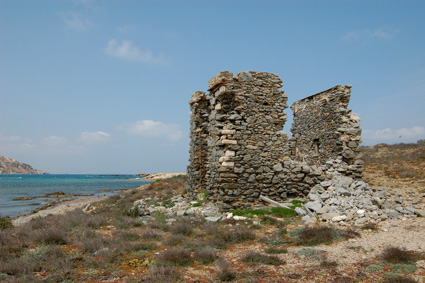
Ruins along the beach
When nothing much is open on Naxos, and there's but one bus per day - it runs, for four hours, out to the far end of the island, then doubles back - entertainment options tend to be rather low-key. But that comes with a lovely tradeoff, of having the beaches all to yourself. We walked for hours one day, along the beach of Aghios Georgios to the still-asleep cluster of little resorts and summer homes of Aghios Prokopios; then down to the lovely beaches of Aghia Anna, where a pair of fishing boats were just returning to port. Aside from that, the only people we saw were workers doing maintenance on the hotels after the winter months.
Even the "All Seasons Cafe" was closed.
From that point, we walked east to Aghios Arsenios, though we didn't know what, if anything, we might find there. The roads weren't empty, though traffic was more than light, as we left the little seaside resort areas and entered an array of small farms. These weren't small farms, in the American sense,5 where a hundred acres is still pretty tiny. Some of these were miniature, with just a handful of livestock, and tiny plots of land. On one, a man was cutting grasses with a hand scythe; others might have two or three cows, or goats, or sheep, or maybe a dozen or so chickens running about the olive, lemon and orange trees.

Naxian rooster
The citrus was ripe, or nearly so, brightly orange and yellow, while the olive trees were just beginning to flower, and the grapevines were just awaking from their winter dormancy. Most of the fields were just being planted, or were still waiting for the winter cover crops - what looked like wheat or barley - to be plowed under. Wildflowers were in bloom in these fields, an eruption of colors that made for a lovely landscape in the afternoon sun. Whites and yellows, with the occasional purple; we even saw some lovely hibiscus flowers covering an old stone wall. Add to that red poppies, with a color so intense that it just about overwhelmed the camera's sensors:
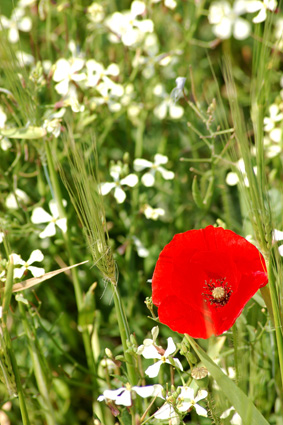
Poppy flower
It really was a beautiful place; though it seems quite a stretch to think I'd want to retire there someday, you can almost understand it when you think that you'd have these sorts of views just outside your door.
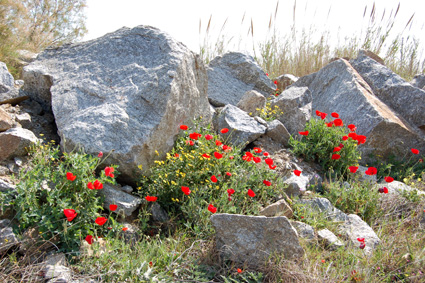
Poppies
* * * * *
1For the most part, "off-season" in the Cyclades doesn't even start until after Easter, nearly a week after we'd already been through.
2Maybe that works for some folks, but not us. Keep in mind that we were going directly from Greece to Scotland, popularly known for deep-frying everything imaginable - Mars bars, most notably - not unlike some Minnesotans I know.
3Oh, there was also the "greens" I had ordered under a salad section of a menu. Rather than a salad full of greens, it was something not unlike collards, boiled to death. I like collards, simmered until tender with some sort of pork, but this was anything but that.
4That's what the menu said. The red and white wines were listed in liter quantities; the retsina and a few others in kilo amounts. It's essentially the same thing in this case, and I've no idea why they did it that way.
5This doesn't fit anywhere else, but I feel compelled to note it. One evening, sitting in the lobby or our little hotel, chatting with Dimitris, a local man who helps run the hotel, and drinking some Greek coffee, we met an American couple. Some very nice folks from Beaver Springs, Pennsylvania, not thirty miles from what will be our new home. And it turns out that Kristen and Mike run Sweet Meriam's Farm, an organic CSA that counts a number of Bucknell faculty among its members. It was, really, the most amazing of coincidences.

1 comment:
Naxos is a very very beatiful island i will agree.And it offers budget accommodations for all.Check this out:
naxos hotels
Post a Comment